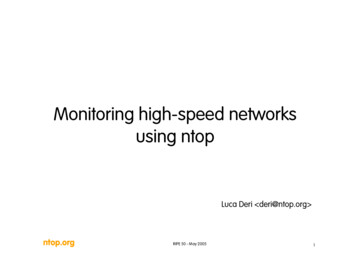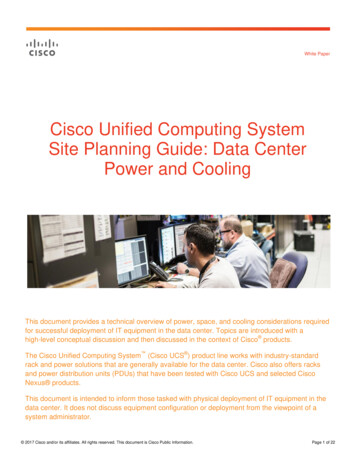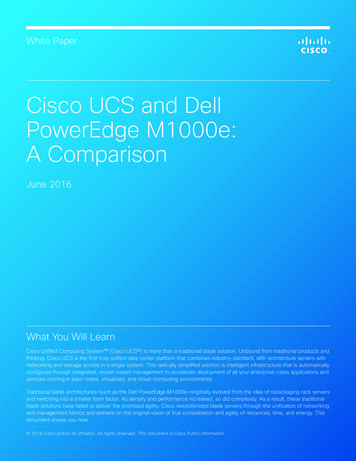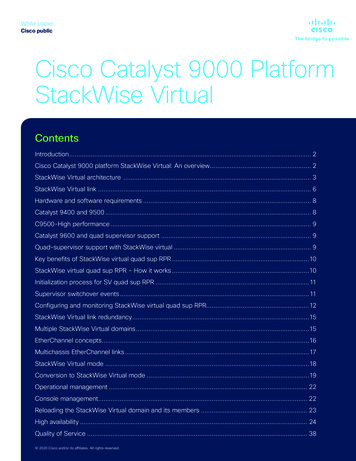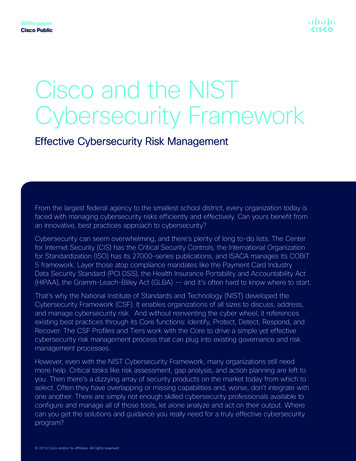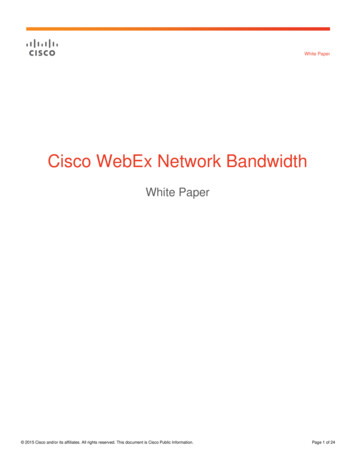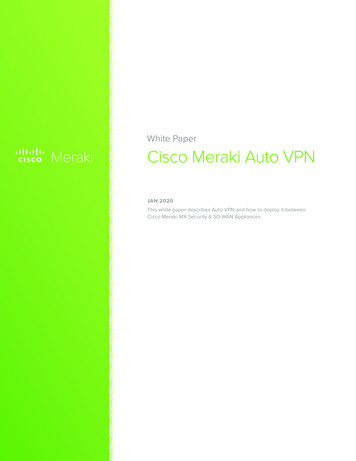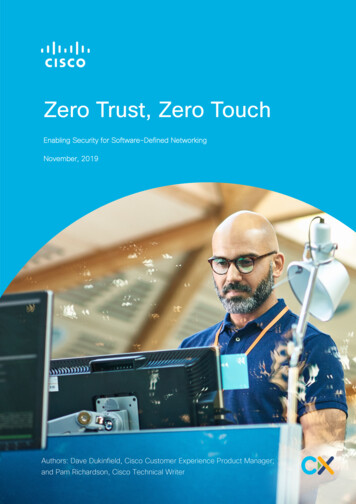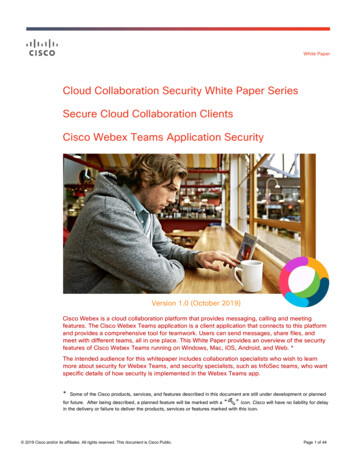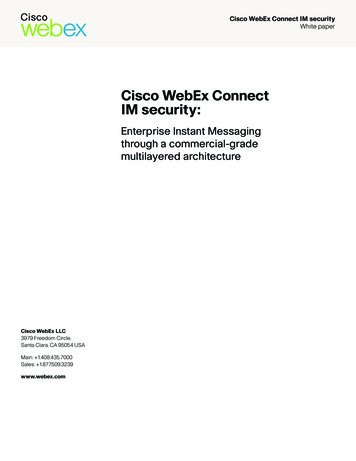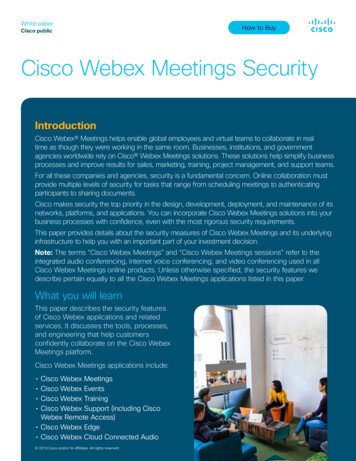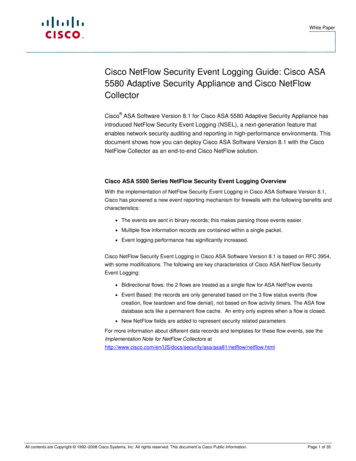
Transcription
White PaperCisco NetFlow Security Event Logging Guide: Cisco ASA5580 Adaptive Security Appliance and Cisco NetFlowCollector Cisco ASA Software Version 8.1 for Cisco ASA 5580 Adaptive Security Appliance hasintroduced NetFlow Security Event Logging (NSEL), a next-generation feature thatenables network security auditing and reporting in high-performance environments. Thisdocument shows how you can deploy Cisco ASA Software Version 8.1 with the CiscoNetFlow Collector as an end-to-end Cisco NetFlow solution.Cisco ASA 5500 Series NetFlow Security Event Logging OverviewWith the implementation of NetFlow Security Event Logging in Cisco ASA Software Version 8.1,Cisco has pioneered a new event reporting mechanism for firewalls with the following benefits andcharacteristics: The events are sent in binary records; this makes parsing those events easier. Multiple flow information records are contained within a single packet. Event logging performance has significantly increased.Cisco NetFlow Security Event Logging in Cisco ASA Software Version 8.1 is based on RFC 3954,with some modifications. The following are key characteristics of Cisco ASA NetFlow SecurityEvent Logging: Bidirectional flows: the 2 flows are treated as a single flow for ASA NetFlow events Event Based: the records are only generated based on the 3 flow status events (flowcreation, flow teardown and flow denial), not based on flow activity timers. The ASA flowdatabase acts like a permanent flow cache. An entry only expires when a flow is closed. New NetFlow fields are added to represent security related parametersFor more information about different data records and templates for these flow events, see theImplementation Note for NetFlow Collectors 81/netflow/netflow.htmlAll contents are Copyright 1992–2008 Cisco Systems, Inc. All rights reserved. This document is Cisco Public Information.Page 1 of 35
White PaperCisco NetFlow Collector OverviewThe Cisco NetFlow Collector allows Cisco customers to collect Netflow Security Logging eventsfrom Cisco ASA 5580 Adaptive Security Appliances and store them into a file as a high-speedlogging collector.Note: Currently, NFC does not support the reporting features available in NFC.More information about the Cisco NetFlow Collector can be found at http://www.cisco.com/go/nfc.Table 1 summarizes the software versions that have been validated for interoperability between theCisco NetFlow Collector and Cisco ASA 5500 Series Adaptive Security Appliances.Table 1.Cisco NetFlow Collector and Cisco ASA Series Adaptive Security Appliances ry 22, 2008Vendor NameCiscoWebsitehttp://www.cisco.comProduct NameCisco NetFlow CollectorVersion and PlatformNFC Version 6.0 on RedHat Enterprise Linux 6.0Cisco ASA Software Version TestedCisco ASA Software Version 8.1 and Cisco ASDM Version 6.1Deployment ScenariosSingle ModeIn this deployment scenario, the Cisco NetFlow Collector is located either on a private (out-of-band)management network or on the inside (trusted) network of the Cisco ASA 5580 Adaptive SecurityAppliance. The Cisco ASA 5580 Adaptive Security Appliance can operate in either routed ortransparent mode.Figure 1 shows the Cisco NetFlow Collector deployed on a private management network of a CiscoASA 5500 Series appliance operating in single, routed mode.Figure 1.Cisco NetFlow Collector with Cisco ASA 5500 Series Security Appliance in Singled, Routed ModeFor a more detailed configuration of this scenario, see Appendix A.Note:In transparent mode, no special configuration is required in Cisco ASA Software Version8.1 other than the standard NetFlow configuration explained later in this document (identical tosingle routed mode).All contents are Copyright 1992–2008 Cisco Systems, Inc. All rights reserved. This document is Cisco Public Information.Page 2 of 35
White PaperMultiple ModeIn this deployment scenario, the Cisco ASA 5580 Adaptive Security Appliance operates in routed ortransparent multiple mode (multiple contexts). Each context will require a separate NetFlowconfiguration to export flow events from that context. Depending on the configuration, NetFlowCollector servers might or might not be shared among the virtual contexts of the Cisco ASA 5580Adaptive Security Appliance.If the Cisco ASA 5580 Adaptive Security Appliance is configured to share interfaces betweenmultiple contexts (such as a management network), all contexts can send NetFlow Security EventLogging events to the same NetFlow Collector server.If the Cisco ASA 5580 Adaptive Security Appliance is configured so that each context operatesindependently, a separate NetFlow Collector server is required for each context to collect flowevents.Figure 2.Cisco NetFlow Collector with Cisco ASA 5500 Series in Multiple, Routed Mode and Shared InsideNetwork.In Figure 2, the Cisco NetFlow Collector is deployed on a network subnet that is shared among allthree virtual contexts (Admin, Context A, and Context B) on the Cisco ASA 5580 Adaptive SecurityAppliance. Each context is configured to send its own NetFlow Security Event Logging events tothe same Cisco NetFlow Collector that is located on the 10.1.1.0/24 subnet. For a more detailedconfiguration, see Appendix B.All contents are Copyright 1992–2008 Cisco Systems, Inc. All rights reserved. This document is Cisco Public Information.Page 3 of 35
White PaperCisco ASA 5500 Series ConfigurationYou can configure the NetFlow feature on Cisco ASA Software Version 8.1 from the command-lineinterface (CLI) or with the Cisco Adaptive Security Device Manager (ASDM).Using the CLITo configure the NetFlow feature using the CLI, perform the following steps:1.Enable NetFlow by entering the flow-export enable command in global configuration mode.ciscoasa(config)# flow-export enable2.Enter the NetFlow Collector information to which Cisco ASA 5580 flow events will be sent.ciscoasa(config)# flow-export destination interfaceNF collector IPaddr UDP portwhere: interface is the Cisco ASA 5580 security interface name through which the NetFlowCollector server can be reached. NF Collector IPaddr is the IP address of the NetFlow Collector. UDP port is the UDP port on which the NetFlow Collector process is listening. By default,NetFlow Collector listens on UDP port 9999.Note:Cisco ASA Software Version 8.1 supports up to two NetFlow Collectors. These twoNetFlow collectors are for redundancy not for load balancing.If you try to configure more than two NetFlow Collectors, an error message appears, as shown inthe following example:ciscoasa(config)# flow-export destination inside 1.1.1.1 2002ERROR: A maximum of two flow-export destinations can be configured.3.Set the NetFlow template refresh interval to 1 minute by entering the flow-export templatetimeout-rate 1 command.Note:By default, the NetFlow template time-out rate is set to 30 minutes, but NFC writesNetFlow events to event log file every minute.For a configuration example on the Cisco ASA 5580 Adaptive Security Appliance, see Appendix A.Other Cisco NetFlow CommandsTable 2 describes additional Cisco NetFlow commands.Table 2.Additional Cisco NetFlow CommandsCommandDescriptionclear configure flow-export(destination)This command is used to clear the flow-export (NetFlow) configuration. The additionaloption (destination) is provided to only clear the destination configurations and leave theremainder of the flow-export configurations.clear flow-export countersThis command resets all the runtime counters of the NetFlow module to zero.show flow-export countersThis command displays a set of runtime counters related to the NetFlow module. Thecounters include statistical data and error data.show running-config flowexport(destination enable template)This command display the NetFlow commands configured. The additional options(destination, enable, template) are provided to filter the commands that will be displayed.logging flow-export-syslogsdisableThis command disable the syslog messages listed all at the same timeAll contents are Copyright 1992–2008 Cisco Systems, Inc. All rights reserved. This document is Cisco Public Information.Page 4 of 35
White PaperCommandDescriptionshow logging flow-exportsyslogsThis command lists the status of the disabled syslog messages, as shown in the followingexample.logging flow-export-syslogsdisableEnabling NetFlow to export flow information makes some syslog messages redundant. Toenhance performance of the Cisco ASA 5500 Series Adaptive Security Appliance, Ciscorecommends that you disable syslog messages that are being exported through NetFlowusing this command. This command makes it easier to disable or enable all these syslogmessages at once.show running-config loggingThis command displays the status of the syslog messages that are also being exported byNetFlow.Using Cisco ASDM to Configure Cisco NetFlowTo configure Cisco NetFlow in Cisco ASDM, choose Configuration Device Management Logging NetFlow, as shown in Figure 3.Figure 3.Configuring Cisco NetFlow in Cisco ASDMCisco NetFlow Collector ConfigurationThis section includes the hardware and software requirements and the steps needed to install,administer, and monitor the NetFlow Collector.Hardware RequirementsCisco NetFlow Collector Software Version 6.0 has the following hardware requirements: Minimum: 2 GB RAM; 73 GB hard disk; dual processor on an entry-level server. Recommended: 4 to 8 GB RAM; two or more 15K SAS 146 GB or greater hard disks; dual3-GHz dual-core (5160) processors on an entry-level server.All contents are Copyright 1992–2008 Cisco Systems, Inc. All rights reserved. This document is Cisco Public Information.Page 5 of 35
White PaperSupported Operating Systems and PlatformsCisco NetFlow Collector Software Version 6.0 supports the following operating systems andplatforms: Red Hat Enterprise Linux 2.1, 3.0, or 4.0 (ES and AS) on an entry-level server, such as anIBM x3550 or x3650 with dual 2.8-GHz or greater Intel Xeon single-core processors or dual3-GHz dual-core (5160) processors. Solaris 8, Solaris 9, or Solaris 10 on an entry-level server with dual 1-GHz or greaterSPARC processors such as a Sun Fire V240.Note:We recommend the CPU, RAM, and disk space options listed previously; however, actualrequirements are determined by your configuration and by the volume and uniqueness of NetFlowdata that is received. Actual resource usage can vary greatly, depending on these factors. A 4-GB x86 box running Red Hat Enterprise Linux 4 with fast disks and dual 3-GHz dualcore (5160) processors is expected to handle at least two million records per minute.InstallationTo install Cisco NetFlow Collector Software Version 6.0, perform the following steps:1.Download Cisco NetFlow Collector Software Version 6.0 from tor-3des (CSCOnfc-6.0.0-31-standard.tar).2.Untar the installation file by entering the following command.‘tar xvf CSCOnfc-6.0.0-31-standard.tar’3.As root, run NFC setup.sh in the resulting top-level directory by entering the ./NFC setup.shcommand at the shell prompt.4.Determine the IP address of the NetFlow Collector server. If there are multiple networkinterfaces, use the IP address that is associated with the hostname.Note:The hostname entry in /etc/hosts must be associated with the NetFlow Collector server’sIP address, instead of the loopback address for licensing to work correctly. (Red Hat EnterpriseLinux associates the hostname with the loopback address by default. This must be changed.)Configuring Cisco NetFlow Collector (NFC)To configure Cisco NetFlow Collector, perform these following steps:1.Download the nfc-config.xml file from the Cisco ASA Software download page cure/asa.shtml and transfer it to theNetFlow Collector server. This file is also available in Appendix C.2.Copy the nfc-config.xml configuration file previously downloaded to the/opt/CSCOnfc/config/ directory. This file establishes which NetFlow fields are logged and theorder in which they appear.3.(Optional) If the NetFlow Collector server has 4 GB or more RAM, open the/opt/CSCOnfc/config/nfcmem file in your favorite text editor, such as vi or emacs, and set theCOLLECTOR MEM MAX parameter to -Xmx2600M. You can increase this value to Xmx3600M later if you have the Red Hat Enterprise Linux "hugemem" kernel and the host hasmore than 4 GB of memory.4.By default, NetFlow Collector listens on UDP port 9999. You can update this value by editingaggregator elements in the nfc-config.xml file or with NetFlow Collector’s Web-basedAll contents are Copyright 1992–2008 Cisco Systems, Inc. All rights reserved. This document is Cisco Public Information.Page 6 of 35
White Paperconfiguration user interface at http://hostname:8080/nfc. You must restart the collectionprocess if you edit the file by hand.Administering Cisco NetFlow CollectorThe owner of Cisco NetFlow Collector processes (specified at installation time) typically performsNetFlow Collector administration, instead of the root.To administer NetFlow Collector, perform the following steps:1.Log into the NetFlow Collector server as the owner of NetFlow Collector processes and enterthe /opt/CSCOnfc/bin/nfcollector start all command to start all NetFlow Collector processes.2.Check the /opt/CSCOnfc/logs/nfc.log file for any errors.3.To stop NetFlow Collector processes, enter the /opt/CSCOnfc/bin/nfcollector shutdowncommand.4.To check the NetFlow Collector process, enter the /opt/CSCOnfc/bin/nfcollector listcommand at the shell prompt.Once NetFlow Collector validates the configuration and the process is started, you can see anentry appears in the nfc.log file that looks like the one below which indicates that NFC processeshave been started properly:[2008-01-25 16:52:30 PST] INFO com.cisco.nfc.collector.NFC - NetFlow Collector startedSimilarly, you can login to NFC Web GUI (http://hostname:8080/nfc) and check that the collector isin “running” status under Status Control page as shown in figure 4.Figure 4.Cisco NetFlow Collector StatusAll NetFlow Collector processes except "re" (scheduled reports) will run continuously until stopped.Usage and OutputTo access the NetFlow Collector Web management interface, go to http://hostname:8080/nfc.All contents are Copyright 1992–2008 Cisco Systems, Inc. All rights reserved. This document is Cisco Public Information.Page 7 of 35
White PaperNetFlow Collector normally performs data reduction by aggregating NetFlow records with matching"key" fields selected by the user in configuration, and periodically writes the aggregated records totime-stamped files. This is different than the behavior needed for Cisco ASA firewall event logswhere all logs are wanted because the appliance has already aggregated the event records.Therefore, an aggregation scheme with the minimum number of key fields that establish recorduniqueness is used: millisecond timestamp of the event, event ID, source and destinationaddresses and ports, and protocol. Other fields in the NetFlow record are recorded as "value"fields, and therefore do not establish record uniqueness.NetFlow Collector outputs Cisco ASA event log files under the /opt/CSCOnfc/Data directory. Thepathname format for NetFlow Collector output files is as follows:/opt/CSCOnfc/Data/aggregator/yyyy mm mFiles are written every minute. The default aggregators and aggregation schemes are called ASAevent-IPv4 and ASA-event-IPv6. (In the future, separate IPv4 and IPv6 files will not be neededwhen a multiple-field-ID key builder is deployed.)Note:NetFlow Collector’s reporting interface should not be used with Cisco ASA firewall logs.The Cisco ASA aggregation schemes use value builders intended for future IPFIX support, forwhich reporting UI support is not yet implemented. Text reports are accessible under/opt/CSCOnfc/Data.Monitor file system usage and update DAYS TO KEEP in the/opt/CSCOnfc/bin/nfc clean up job.sh file, according to disk capacity and the observed rate ofgrowth.Use the Health Monitor on the Status page in the NetFlow Collector Web UI to monitor collectormemory occupancy and records per period as shown in figure 5.Figure 5.Cisco NetFlow Collector Health MonitoringAll contents are Copyright 1992–2008 Cisco Systems, Inc. All rights reserved. This document is Cisco Public Information.Page 8 of 35
White PaperConclusionCisco ASA Software Version 8.1 offers next-generation NetFlow Security Event Logging feature.This feature enables customers to perform network security auditing and reporting in highperformance environments when deployed with a NetFlow collector such as the Cisco NetFlowCollector.All contents are Copyright 1992–2008 Cisco Systems, Inc. All rights reserved. This document is Cisco Public Information.Page 9 of 35
White PaperAppendix A: Configuration Example in Single, Routed ModeASA Version 8.1(1)When releasing externally, this should probably say 8.1.1?hostname ciscoasaenable password xxxxxx encryptednames!interface Management0/0nameif Managementsecurity-level 100ip address 10.10.10.1 255.255.255.0management-onlyinterface Management0/1shutdownno nameifno security-levelno ip address!interface TenGigabitEthernet5/0nameif insidesecurity-level 100ip address 192.168.1.1255.255.255.0!interface TenGigabitEthernet5/1nameif outsidesecurity-level 0ip address 172.16.0.1 255.255.255.0!interface TenGigabitEthernet7/0shutdownno nameifno security-levelno ip addressinterface TenGigabitEthernet7/1shutdownno nameifno security-levelno ip addresspasswd xxxxxxx encryptedboot system disk0:/asa810-k8.binftp mode passiveclock timezone PST -8clock summer-time PDT recurringpager lines 24All contents are Copyright 1992–2008 Cisco Systems, Inc. All rights reserved. This document is Cisco Public Information.Page 10 of 35
White Paperno logging message 106015no logging message 313001no logging message 313008no logging message 106023no logging message 710003no logging message 106100no logging message 302015no logging message 302014no logging message 302013no logging message 302018no logging message 302017no logging message 302016no logging message 302021no logging message 302020logging enable!send NetFlow events to the NFC on the Management subnetflow-export destination Management 10.10.10.100 9999!Set flow template to 1 minuteflow-export template timeout-rate 1!Enable Netflow Security Event Loggingflow-export enablemtu Management 1500mtu inside 1500mtu outside 1500mtu inside1 1500mtu outside1 1500no failovericmp unreachable rate-limit 1 burst-size 1asdm image disk0:/asdm-61029.binno asdm history enablearp timeout 14400no nat-controltimeout xlate 3:00:00timeout conn 1:00:00 half-closed 0:10:00 udp 0:02:00 icmp 0:00:02timeout sunrpc 0:10:00 h323 0:05:00 h225 1:00:00 mgcp 0:05:00 mgcppat 0:05:00timeout sip 0:30:00 sip media 0:02:00 sip-invite 0:03:00 sipdisconnect 0:02:00timeout sip-provisional-media 0:02:00 uauth 0:05:00 absolutedynamic-access-policy-record DfltAccessPolicyhttp server enablehttp 0.0.0.0 0.0.0.0 Management!class-map global-classmatch default-inspection-traffic!!policy-map global-policyAll contents are Copyright 1992–2008 Cisco Systems, Inc. All rights reserved. This document is Cisco Public Information.Page 11 of 35
White Paperclass global-classinspect dnsinspect esmtpinspect ftpinspect h323 h225inspect h323 rasinspect rshinspect rtspinspect sipinspect skinnyinspect sqlnetinspect sunrpcinspect tftpinspect xdmcp!service-policy global-policy globalprompt hostname 28dc: endAll contents are Copyright 1992–2008 Cisco Systems, Inc. All rights reserved. This document is Cisco Public Information.Page 12 of 35
White PaperAppendix B: Configuration in Multiple Context, Routed ModeSystem ContextHostname ciscasapassword xxxxenable password xxxxasdm image disk0:/asdm.binboot system disk0:/image.binma
NetFlow Collector as an end-to-end Cisco NetFlow solution. Cisco ASA 5500 Series NetFlow Security Event Logging Overview With the implementation of NetFlow Security Event Logging in Cisco ASA Software Version 8.1, Cisco has pioneered a new event reporting mechanism for f
